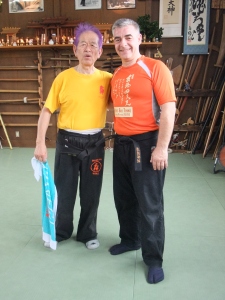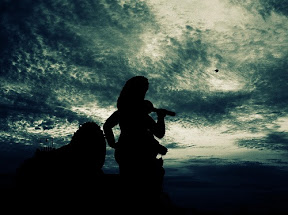From Shiro Kuma's Weblog by kumablog

the group posing with sensei in front of takamatsu memorial
Today a group of buyu from all over the world where lucky to visit once again Sensei’s second house.
Today around 11:30, we met with Akira, Noguchi, Darren, Collado, Miller, Eguia and a few others at the hombu where Senô sensei was teaching a group of students sweating in the terrible heat of the day.

you can see here how bad I felt in the AC 
The heat and humidity were at their peak today and I felt bad to be in the car with Noguchi sensei (and the AC). When the group was complete with Darren and his car we drove to the Tsukuba mountain where sensei has located his second house.
This is there that he spends a lot of time painting, writing, and taking care of his many animals.

A real gentleman farmer!
When we arrived we were welcomed by sensei dressed like a real gentleman farmer in his country outfit.
Many practitioners see him as “non human” and not only because he always repeats that he is a UFO.
The bujinkan is a system to live a happy life and he was shining happiness and expressing it like he does with his budô.
I love to see him so happy in his daily life.

the group preparing for the incense
In the garden each one of us lit some incense sticks to the 9 statues of the nine schools and we all prayed to the memory of Takamatsu sensei in front of the memorial of 6 tons built in the garden.
Do you know that in his office in Noda sensei prays everyday for the memory of his parents, of Takamatsu sensei but also for the sake of the shidôshi of the bujinkan?
Sensei is very religious person and only a few of the bujinkan students know that. Over the years when I was helping him for some work, I saw him a few times praying while we were working.

sensei and one of the poneys
In the garden there is a green house that we use in winter, a small arena where sensei “walks” the poneys, a small stable for the poneys and many staues and carved stones carved with the name of the nine schools.
The garden is filled with statues of divinities, symbolic rocks and carved texts.
After padding Kuki and Tobi, the two poneys of sensei and taking care of the dogs (asuka, mae and a third one), the water turtles in their basin, it was time to ”pay our respect” to the statue of Marylin Monroe (sensei likes her very much).

Noguchi sensei and Marylin (a classic) 
I have been visiting this house many times since sensei has decided to split his time between Noda and Tsukuba.
And the “Marylin game” has become some sort of ritual over the years.
I think I have pictures of all the high ranks of the bujinkan (including me) having fun with the american star. as he puts it, life is too short to take it too seriously.
Put laughter in your life – rokkon shôjô
Then it was time to eat and the whole group climbed into the cars and we all went to have lunch with sensei in a restaurant nearby.

ten chi jin?
The house is surrounded by rice fields on the plains down the Tsukuba mountain.
It is strange to be there after the being in the citadin life of kashiwa city or Atago.
With the heat hammering everything, it felt like being in another country. No noise, no wind only the sound of the cicadas in the trees.
A special thank you to Darren for keeping cool bottles of water in the car after the heat of the garden.
It was a real enjoyment.

In the restaurant
The poor restaurant keeper had a hard time coping with a sudden arrival of so many gaijin.
I have seen that many times over the years and I believe that sensei loves to do that.
As always this is a very special moment and I am sure that many bujinkan practitioners would have liked to be there with us. We felt privileged and honored to spend these special moments with him.

the group with the translator
 Since my last visit many new stones and stones have been added. The one on the left is to remember all our bujinkan buyu who dies since the beginning.
Since my last visit many new stones and stones have been added. The one on the left is to remember all our bujinkan buyu who dies since the beginning.
Death is what makes Life worth it explained sensei to the group in the restaurant. Because we train techniques to bring death to our opponent we develop by contrast a strong feeling of life.
Many times during lunch sensei spoke of our future Hombu dôjô that will be built soon to become some kind of cultural centre for the world.
Sensei asked us also to share these moments of true kumite with the buyu from all over the world this is why this long article is written for.

the last drink before closing this fantastic day
It was time to go back to our lives in the city and after a last teas in one of the room of the house with the walls covered by the many presents, sensei has received during all these years, we departed.
We left sensei benefiting from the rest of this day and from the happiness it has given us all.
Funnily during lunch he thanked us twice to have been able to come!

Hatsumi & Noguchi sensei enjoying the instant
Be happy and do not take your life too seriously – simply enjoy beautiful moments like this one.
Shikin Haramitsu Daikomyô






…
 …
…


 …
…


 …
…



 …
…











 …
…
 …
…

 …
…